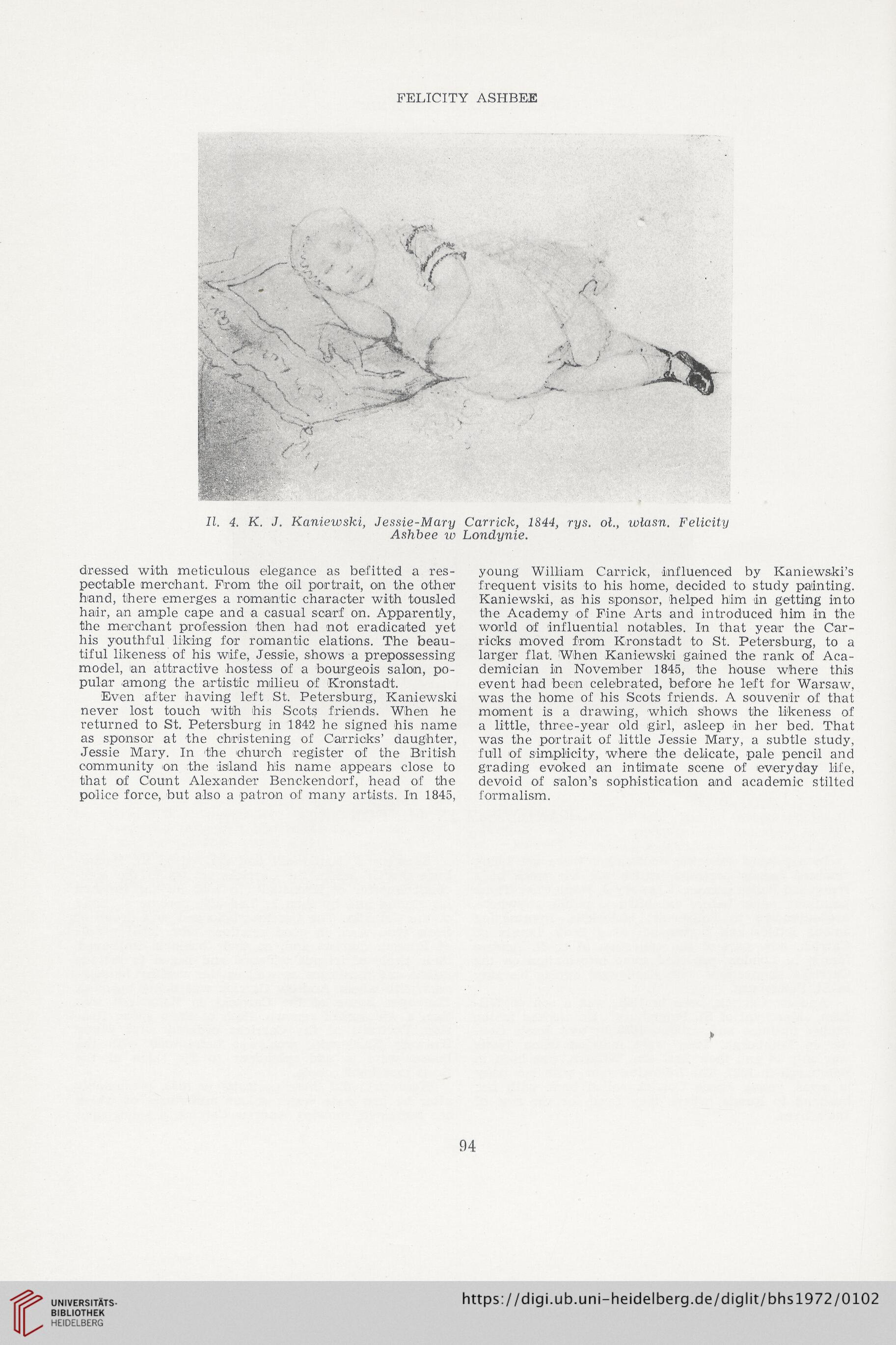FELICTTY ASHBEE
U. 4. K. J. Kaniewski, Jessie-Mary Carrick, 1844, rys.
Ashbee w Londynie.
oł., własn. Felicity
dressed with meticulous elegance as befitted a res-
peotable merohant. From the olil portrait, on the other
hiand, tihere emerges a romantic character with tousled
hair, an ample cape and a casual scarf on. Apparently,
the merohant profession then had not eradicated yet
his youthful liking for romantic elations. The beau-
tiful likeness of his wife, Jessie, shows a prepossessing
model, an attractive hostess of a bourgeois salon, po-
pular among the artistic miilieu of Kronstadt.
Even after having left St. Petersburg, Kaniewski
never lost touch with his Scots friends. When he
returned to St. Petersburg in 1842 he signed his name
as sponsor at the christening of Carricks’ daughter,
Jessie Mary. In the Ohurch register of the British
community on the isiland his name appears close to
that of Count Alexander Benckendorf, head of the
police force, but also a patron of many artists. In 1845,
young William Carrick, influenced by Kaniewski’s
freąuent visits to his home, decided to study painting.
Kaniewski, as his sponsor, helped him in getting into
the Academy of Fine Arts and introduced him in the
world of influential notables. In that year the Car-
rioks moved from Kronstadt to St. Petersburg, to a
larger fiat. When Kaniewski gained the rank of Aca-
demician in Novemlber 1845, the house where this
event had been celebrated, before he left for Warsaw,
was the home of his Scots friends. A souvenir of that
moment is a drawing, whioh shows the likeness of
a little, three-year old girl, asleep in her bed. That
was the portrait of little Jessie Mary, a subtle study,
fuli of simplicity, where the delicate, pale pencil and
grading evoked an intimate scene of everyday life,
devoid of salon’s sophistication and academic stilted
formalism.
94
U. 4. K. J. Kaniewski, Jessie-Mary Carrick, 1844, rys.
Ashbee w Londynie.
oł., własn. Felicity
dressed with meticulous elegance as befitted a res-
peotable merohant. From the olil portrait, on the other
hiand, tihere emerges a romantic character with tousled
hair, an ample cape and a casual scarf on. Apparently,
the merohant profession then had not eradicated yet
his youthful liking for romantic elations. The beau-
tiful likeness of his wife, Jessie, shows a prepossessing
model, an attractive hostess of a bourgeois salon, po-
pular among the artistic miilieu of Kronstadt.
Even after having left St. Petersburg, Kaniewski
never lost touch with his Scots friends. When he
returned to St. Petersburg in 1842 he signed his name
as sponsor at the christening of Carricks’ daughter,
Jessie Mary. In the Ohurch register of the British
community on the isiland his name appears close to
that of Count Alexander Benckendorf, head of the
police force, but also a patron of many artists. In 1845,
young William Carrick, influenced by Kaniewski’s
freąuent visits to his home, decided to study painting.
Kaniewski, as his sponsor, helped him in getting into
the Academy of Fine Arts and introduced him in the
world of influential notables. In that year the Car-
rioks moved from Kronstadt to St. Petersburg, to a
larger fiat. When Kaniewski gained the rank of Aca-
demician in Novemlber 1845, the house where this
event had been celebrated, before he left for Warsaw,
was the home of his Scots friends. A souvenir of that
moment is a drawing, whioh shows the likeness of
a little, three-year old girl, asleep in her bed. That
was the portrait of little Jessie Mary, a subtle study,
fuli of simplicity, where the delicate, pale pencil and
grading evoked an intimate scene of everyday life,
devoid of salon’s sophistication and academic stilted
formalism.
94




